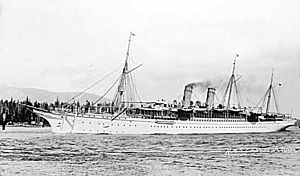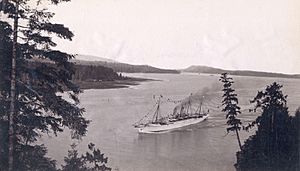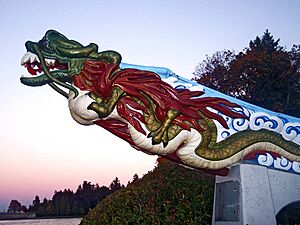RMS Empress of Japan (1890) facts for kids

Empress of Japan
|
|
Quick facts for kids History |
|
|---|---|
| Name | Empress of Japan |
| Owner | |
| Port of registry | Canada |
| Builder | Naval Construction & Armaments Co, Barrow-in-Furness |
| Launched | 13 December 1890 by Lady Alice Stanley |
| Out of service | 1922 |
| Fate | Scrapped in 1926 |
| General characteristics | |
| Type | Ocean liner |
| Tonnage | 5,905 tons |
| Length | 456 ft (139 m) |
| Beam | 51 ft (16 m) |
| Propulsion | twin propellers |
| Speed | 16 knots |
| Capacity |
|
The RMS Empress of Japan was a famous ocean liner, a large ship that carried passengers across the ocean. People sometimes called her the "Queen of the Pacific" because she was so important. She was built in England between 1890 and 1891 for a company called Canadian Pacific Steamships (CP).
This ship was the first of two ships named Empress of Japan for CP. She regularly traveled across the Pacific Ocean between Canada and countries in Asia until 1922. During World War I, she became a warship called an armed merchant cruiser. This meant she was armed with weapons and served the Royal Navy as HMS Empress of Japan.
Over her career, the Empress of Japan traveled an amazing 4 million kilometers (2.5 million miles). She crossed the Pacific Ocean 315 times, carrying many people and goods.
In 1891, the Canadian Pacific Railway (CPR) and the British government made a deal. The CPR would get money to help carry mail between Britain and Hong Kong through Canada. Three special ocean liners were built for this route, and each was given an "Imperial" name.
The Empress of Japan and her two sister ships, RMS Empress of China and RMS Empress of India, were very important. They formed the main part of the CPR's fleet that sailed the Pacific for the next 50 years.
Contents
Building a Pacific Queen
The Empress of Japan was built by a company called Naval Construction & Armaments Co. in Barrow-in-Furness, England. This company is now part of Vickers Armstrongs. The ship weighed 5,905 tons and was about 455.6 feet (138.9 meters) long. She was also 51.2 feet (15.6 meters) wide.
The ship was painted white and had a special front shape called a "clipper-bow." She had two tall, buff-colored funnels with black tops. She also had three light masts, like a schooner. The Empress of Japan could travel at an average speed of 16 knots (about 30 kilometers per hour).
Empress of Japan and her two sister ships were special because they were the first ships in the Pacific to have two propellers. These propellers were powered by engines that moved back and forth. The ship was designed to carry 770 passengers. This included 120 first-class passengers, 50 second-class passengers, and 600 passengers in a cheaper section called "steerage."
Launching and First Journeys
The Empress of Japan was launched on December 13, 1890. Lady Alice Stanley, whose father-in-law was the Governor General of Canada, helped launch the ship. This was a big event!
The ship left Liverpool, England, on April 11, 1891, for her first trip. She sailed through the Suez Canal to Hong Kong and then to Vancouver, Canada. She arrived in British Columbia on June 2. After that, she regularly sailed between Canada and Asia.
In the early days of wireless radio, the Empress of Japan's special call sign was "MPJ." Besides passengers, she also carried important goods like Japanese tea.
A Record-Breaking Ship
The Empress of Japan was part of a group of "Empress" ships, but she was very famous. She held the speed record for crossing the Pacific Ocean for more than 20 years! In 1897, Captain Henry Pybus led the Empress of Japan to win the "blue ribbon" for the fastest Pacific crossing.
This proud ship continued to sail across the Pacific until 1922. After that, she stayed in Vancouver's harbor for several years. The special dragon figurehead, a carved decoration from the front of the ship, was saved. It is now kept at the Seawall in Stanley Park in Vancouver.
Serving in World War I
During World War I, also known as the Great War, the Empress of Japan was changed into an Armed merchantman. This meant she lost her fancy white look and became a warship. There was an agreement that if war broke out, the ship would be used by the military.
In 1914, just two days before the Empress of Japan arrived in Yokohama, Japan, World War I started in Europe. The British Navy quickly took over the ship. She was then refitted to become an Armed Auxiliary Cruiser. After the war ended, the Empress of Japan was the only one of the first three "Empress" ocean liners to return to her regular Pacific route.
In 1923, the old ship was used in a different way. The Canadian Pacific company used the Empress of Japan to house workers during a disagreement with a workers' group in Vancouver. The ship stayed docked in Vancouver's harbor until 1926. Eventually, Canadian Pacific replaced her with a new ship, which was also named Empress of Japan.
What Happened to the Ship's Parts?
When the Empress of Japan was taken apart, or "salvaged," her figurehead was thrown away. However, the Vancouver Daily Province newspaper rescued it. It was fixed up and put on display in Vancouver's Stanley Park in 1927.
In 1960, a copy of the figurehead, made of fiberglass, replaced the original because the old one was starting to fall apart. The original figurehead was fixed again and is now kept at the Vancouver Maritime Museum.
Some parts of the ship's beautiful inside were also taken by people who owned expensive homes in Vancouver. They added these parts to their houses.
Images for kids




